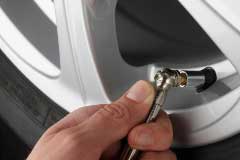Some Important Reminder for Driving Overloaded Vehicles - Vol.26
Your car is overloaded when you exceed the total load capacity of all your tires at maximum inflated pressure. You get this much info somewhere on the side of your tire where is may read something like "Max. Load 1600 lbs. at 32 psi…."
This means that when fully inflated, the tire can safely support only 1600 lbs. If made to sustain a heavier weight, the tire will be subject to excess pressure which may result in it blowing (especially if it is an old tire). If made to sustain weights that are heavier than its load limit, the lifespan of the tire is shortened.
The vendor of the tire can usually supply his clients with a table indicating the load capacity with different inflated pressures of the tire the client bought. It is useful to keep this table in the car to determine if at any time before and during a trip, your vehicle is overloaded.

The total weight of the car, including its passengers and cargo may be within the load limit of the tires when you start the trip. But since tires lose air while on the road, a point may be reached when the tire pressure is too low for the total original weight of the car. In that case, the car is considered overloaded.
To avoid this scenario, you can avail of certain safety devices which can be installed into the tires and which monitors the tire pressure in real time. Using the chart given by the vendor of the tire, the driver can ascertain if his vehicle is overloaded and take the proper measure to remedy the situation.
Overloading makes driving a hazard for everything and everyone involved. The driver himself will find the wheels sticky, the suspension of the car will sag and eventually give out with repeated overloading. The clutch will also be adversely affected by too much weight in the vehicle. Because of the constant danger of blowing the tires, overloading is a potential hazard for other motorists on the road.
Overloaded vehicles will also be harder to get to a full stop. This may impair the ability of the driver to bring the car or truck to stop in time to prevent an accident from happening.

Overloading may not just involve exceeding the load limit of the tires. Creating imbalance in the pressure exerted on the axles by uneven distribution of cargo also results in damaging the axles. Since the vehicle is imbalanced, the tendency for it to tip over is also increased. There are mechanisms by which the axle weights can be determined.
Besides safety considerations, there are many reasons why you should not drive an overloaded vehicle.
An overloaded vehicle, once apprehended by the law will be required to unload items to get it back to within its loading capacity. If an overloaded vehicle figures in an accident, the driver and owner will be held liable for any damages inflicted on others. In case the accident proves fatal to the third party, both driver and owner can be prosecuted for manslaughter and dangerous driving.
An overloaded vehicle, which figured in an accident usually, forfeits any claims for benefits it may have from insurance companies. This is done to discourage overloading of vehicles.
In summary, to be sure your car of truck will never be carrying more load than it can, you should keep the maximum load chart supplies by the vendor of the tire. Have a device which monitors tire pressure installed. Before starting out on a trip, have the weight on the axles checked. They should be more or less equal.